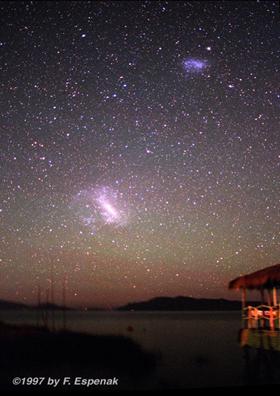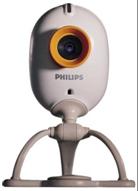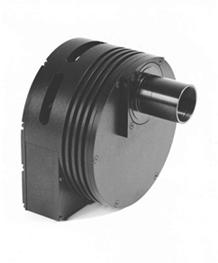|
CCD's Versus Traditional Photography - by Ricky Leon Murphy:
Introduction
The Equipment
Olympus OM-1
Phillips ToUcam
CCD Camera
Putting it all together
Summary
References
Image Credits
Back to
Astrophotography
Introduction:
Astrophotography is a fun
and rewarding hobby. While some consider the merits of this hobby to be
scientific in value, it is no secret and no surprise that many
photographs take on an artistic appearance. Even more so, artistic skill
is almost a requisite for producing some of the more stunning images. As
with any artist and their creation, there is no right or wrong piece of
equipment – only a right tool for the job. In astrophotography, there is
no one magic tool that does it all. Instead, a variety of telescopes and
cameras provide the ability to capture a large variety of objects –
lunarscapes, planets, nebula and galaxies.
Back to Top
| Back to
Astrophotography
The Equipment:
I am lucky enough to have
what I consider to be a perfect set of tools for astrophotography.
The crux of the photographic system lies on my equatorial mounted wedge
of my Meade 10” Schmidt-Cassegrain telescope with a Takahashi Sky 90
wide field telescope mounted “piggy-back” on the Meade (meaning it is
mounted directly on top of the main telescope). I am also lucky enough
to have three different cameras:
-
Olympus OM-1 SLR
Camera Body
-
Phillips ToUcam Pro
– webcam
-
Santa Barbara
Instrument Groups ST-9XE CCD camera
This variety of cameras
allows me to photograph anything I want in the night sky – as long as
the object is within reach of my optical system.
Back to Top
| Back to
Astrophotography
Olympus OM-1:
A 35mm SLR camera may
seem like an old piece of equipment when comparing to today’s CCD camera
capabilities, however there are still some things that are the domain of
SLR cameras. While any SLR camera body with a “B” setting will work, the
OM-1 is special because it does not use battery power when the shutter
is open.
|

Figure 1 |

Figure 2 |
The “B” setting on an SLR
camera is called “Bulb.” What this does is allow the shutter of the SLR
camera to remain open during an exposure – a requirement when
photographing extremely faint objects. There are four major benefits for
using an SLR camera for astrophotography.
-
Star trail
photography – a stationary SLR camera is left pointing at an area of
sky with the shutter open for at least 15 minutes.
-
Wide angle
photography – while CCD’s have reached the size of a 35mm frame,
they are extremely expensive. And SLR is much cheaper and can take
some wonderful wide field images.
-
Color photography –
color film can be used without any loss in overall resolution, and
the color image is captured in one frame.
-
The versatility of
the SLR – the body of the camera can be easily fixed to any
telescope and can also accept a wide variety of SLR lenses, like
wide angle “fish-eye” lenses or telephoto lenses. They can also
operate without a telescope.
With this camera, my
target choices are pretty broad: star trails, wide-angle photography,
meteor shower photography, and single shot color imagery through the
telescope. One of the best features of this camera is its portability. I
do not need to carry computers and power supplies if I want to capture
some images. Additionally, if I do want to photograph though the
telescope, I can take a color image without having to take three to four
different exposures through filters as well as dozens of flat field and
dark frames (for image calibration of the CCD camera).
Here are a few samples of
what a 35mm SLR camera can do:
Figure 3: Star Trail Image
 |
Figure 4: A two
in one image – the first image is guided “piggy-backed” on an
equatorial mounted telescope for several minutes while the
second exposure is of the foreground.
|
Back to Top |
Back to
Astrophotography
Phillips ToUcam Pro:
It is difficult to
imagine that a webcam can be useful in astrophotography. In fact,
specially modified webcams have shown to be very capable with deep-sky
photography (Wiley, 2003). Webcams can be modified to include a variety
of cooling system and software designed to override the shutter;
however, since we already have an SLR camera and a CCD camera there is
no need for modifying our webcam.
|

Figure 5: |
The Phillips
ToUcam (no longer available) has proven to be the choice for
planetary imaging. With its small CCD sensor at 640K by 480K,
the size seems “just right” for photographing planets through
our Meade 10” telescope. Special adapters can be purchased
through places like
ScopeTronix to facilitate connection to a telescope. |
What makes the webcam
special for planetary imaging is its ability to capture up to 30 frames
a second. While not a regular snapshot type of image, the individual
frames can be “stacked” by special programs like
RegiStax or
Registar. This image stacking
reduces overall noise, and since planets are relatively bright compared
to deep sky objects, a short exposure is possible - in addition CCD’s
have the ability to be more sensitive than film (Covington, 1999).
The image below shows
just how capable a webcam can be for capturing images of the planets.
|
Figure
6:
 |
This image of
Jupiter was captured by Glen Schaeffer using a ToUcam webcam
attached to a 20” Obsession Dobson telescope. Very nice indeed. |
While the webcam can
excel at planetary imaging, the small CCD size limits any possibility of
wide angle photography. Additionally, the shutter cannot be left open
without modifications so any other astrophotography is not possible –
unless time and effort is made to modify the camera. See Astronomy
Magazine, December 2003 issue, page 94 for modification tips.
Back to Top
| Back to
Astrophotography
The CCD Camera:
Volumes can be written
about CCD’s, but the main emphasis here is to determine the place of a
CCD camera in an existing astrophotography setup. In reality, a
carefully researched product (and enough money) can probably by a CCD
that can perform almost all aspects of astrophotography – including wide
field photography. However in our case, I happen to have (see footnote
number 1) a CCD camera that augments my existing setup.
|

Figure 7: |
Santa Barbara
Instrument Group’s ST-9XE camera uses a 512K by 512K array CCD
of 24 micron pixels. While this may seem like a low resolution
for this camera, it is ideal for the long focal length of the
Meade 10” telescope. This particular camera does not offer a
wide field, but actually falls somewhere in the middle between
the 35mm camera and the webcam. |
More information on CCD
and telescope choice can be found in The New CCD Astronomy by Ron
Wodaski. The main concern with focal length and pixel size is something
called image scale. The resolution of a star is so small that using a
small pixel camera on a long focal length telescope results in over
sampling (Wodaski, 2002) – a single star can fall on a group of smaller
pixels, but offer no benefit to overall quality. On the other hand, this
camera will not work well with my Takahashi Sky 90 because the pixels
are too large – several stars can fall on one pixel resulting in an
under-sampled image.
Images that have been
captured by the ST-9XE camera on a long focal telescope are actually
pretty impressive:
|

Figure 8: M33 |

Figure 9: NGC 891 |
My target choices for
this CCD camera and my 10” telescope will be:
-
The variety of deep
space objects – galaxies, star clusters, planetary nebula
-
Planetary and lunar
images
-
High resolution
mosaics
of larger galaxies and nebula
In addition to all of the
deep space objects, I can even do some science with the ST-9XE,
including:
-
Searching for
supernova
-
Searching for
transits of exoplanets
While CCD’s seem magical
to use, there is a dark side. To capture a single image, image
calibration must also be performed. What image calibration does is
negate the flaws within a CCD and calibrate the dark levels. For
example, if a CCD has damaged pixels or does not evenly record light
levels evenly, image calibration can eliminate these effects. The
process of image calibration is as follows:
-
Capture the image of
interest
-
Capture a dark frame
(a single image with the shutter closed)
-
Capture a bias frame
(a single image with the shutter closed for the same duration as the
target image)
-
Capture a flat field
image (an image with a t-shirt over the telescope)
-
Use image software
like
CCDSoft or
MaxImDL to combine these images to a final product
The interested reader is
encouraged to read Ron Wodaski’s The New CCD Astronomy for a more
detailed look into the image processing procedures.
These image calibration
steps must be performed for each filter if a color image is desired. To
capture a color CCD image – since the CCD is monochromatic – the object
must be captured through red, green and blue filters then combined with
software (Covington, 1999).
Back to Top
| Back to
Astrophotography
Putting it all
together:
To sum up the
capabilities and target choices for my three cameras, I have created a
nice summary:
|
|
35mm SLR: |
Phillips
ToUcam: |
SBIG ST-9XE |
|
Accessories: |
Can be
adapted to any telescope and accept a wide variety of lenses |
Cannot accept
additional lenses and must be specially adapted to a telescope |
Can fit on
any telescope and additional components are required for
additional lenses |
|
Portability: |
No power
supplies or telescopes needed. Can operate alone |
Must be
attached to a computer and a telescope |
Can operate
away from a telescope with a lenses, but a computer and power
supply must follow |
|
Color
Photography: |
Yes – with
color film |
Yes – by
design |
Yes – with
special filters and exposures for each filters. A computer is
required for processing |
|
Ease of use: |
Just aim,
focus and expose |
Just aim the
telescope, focus, and expose, process with computer |
Requires
numerous calibration images along with the object of interest as
well as computer skills |
|
Target
Options: |
Anything |
Planets |
Deep sky
objects, narrow field photography, and science images |
|
Best choice
for: |
Star trails,
wide angle photography, color photography |
Planets |
Deep space
objects, supernova, science images |
|
Use on Meade
10”: |
Yes |
Yes |
Yes |
|
Use on
Takahashi Sky 90: |
Yes |
No – objects
too small and chip too small |
No – chip too
small and pixel size too large |
Back to Top
| Back to
Astrophotography
Summary:
Astrophotography covers a
wide variety of subjects – from wide angle views of constellations,
close up views of planets, and images of distant galaxies. With the
highlighted setup of cameras and telescopes, I have demonstrated that
there is no one perfect instrument. A 35mm SLR film camera has its place
for wide angle and color photography and beautiful star trail images. A
webcam has been shown to be more than competent in imaging the planets
while the CCD camera fills in the blanks. The added benefit of
scientific imaging is also possible with the CCD camera. With a balanced
toolbox of imaging equipment, the hobby of astrophotography will be
complete and rewarding.
Back to Top
| Back to
Astrophotography
References:
Covington, Michael.
Astrophotography for the Amateur. Second Edition. Cambridge
University Press, 1999.
Wiley, Keith. “Imaging
with Webcams.” Astronomy Magazine, December 2003, pages 94 to 97.
Wodaski, Ron. The New
CCD Astronomy. New Astronomy Press. Duvall, WA. 2002.
Back to Top
| Back to
Astrophotography
Image Credits:
Figure 1:
http://www.mir.com.my/rb/photography/hardwares/classics/olympusom1n2/html/m3.htm
Figure 2:
http://science.howstuffworks.com/camera7.htm
Figure 3:
http://www.mreclipse.com/Astrophoto/SSSP97.html
Figure 4:
http://www.mreclipse.com/Astrophoto/sssp97/97SS82.jpg
Figure 5:
http://www.neatherd.org/astronomy/Toucam.jpg
Figure 6:
http://home.houston.rr.com/gschaeffer/astropix/astropix.html
Figure 7 and 8:
http://www.sbig.com
Figure 9:
http://users.easystreet.com/daves/ccdimages.html
Back to Top |
Back to
Astrophotography |

